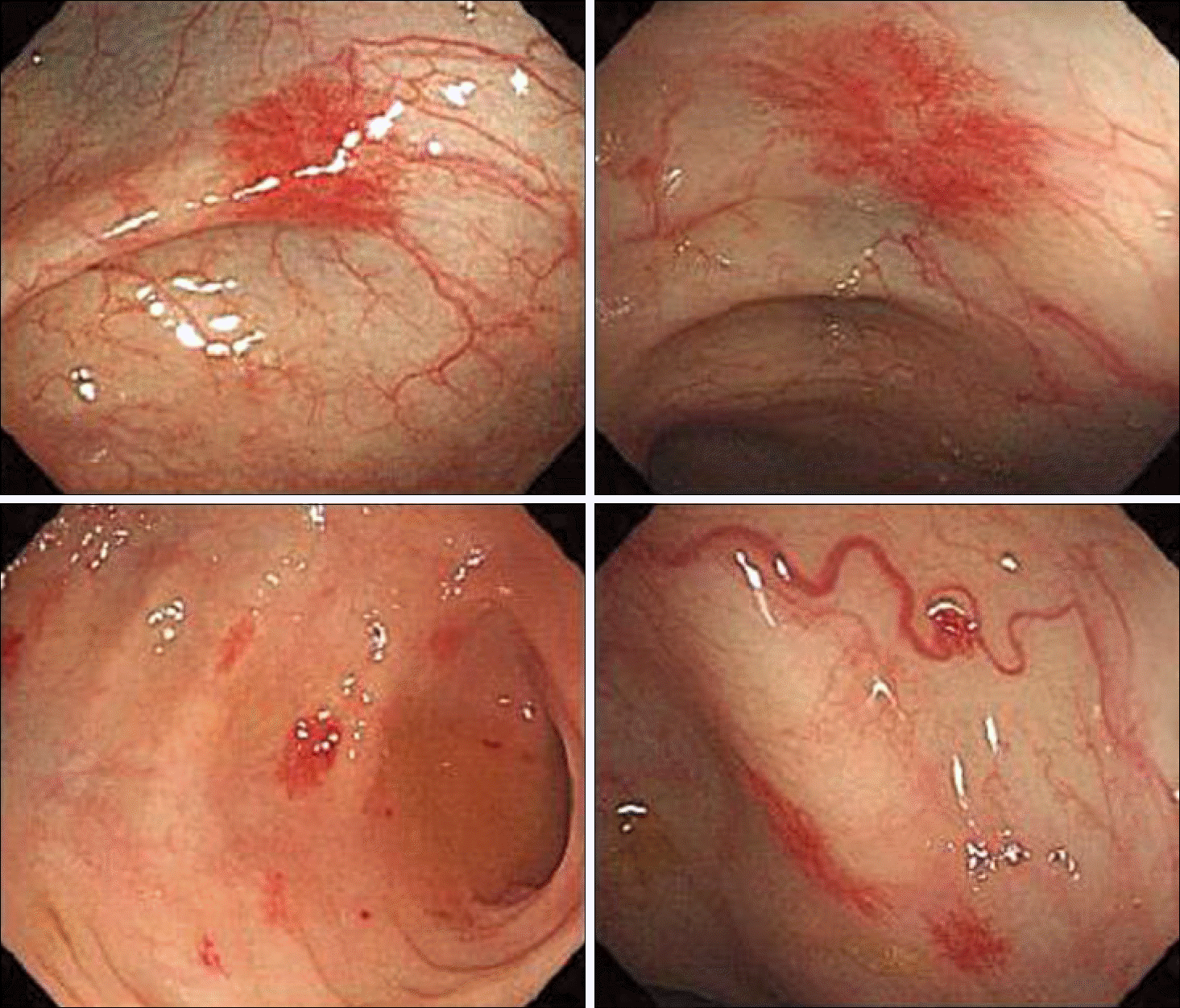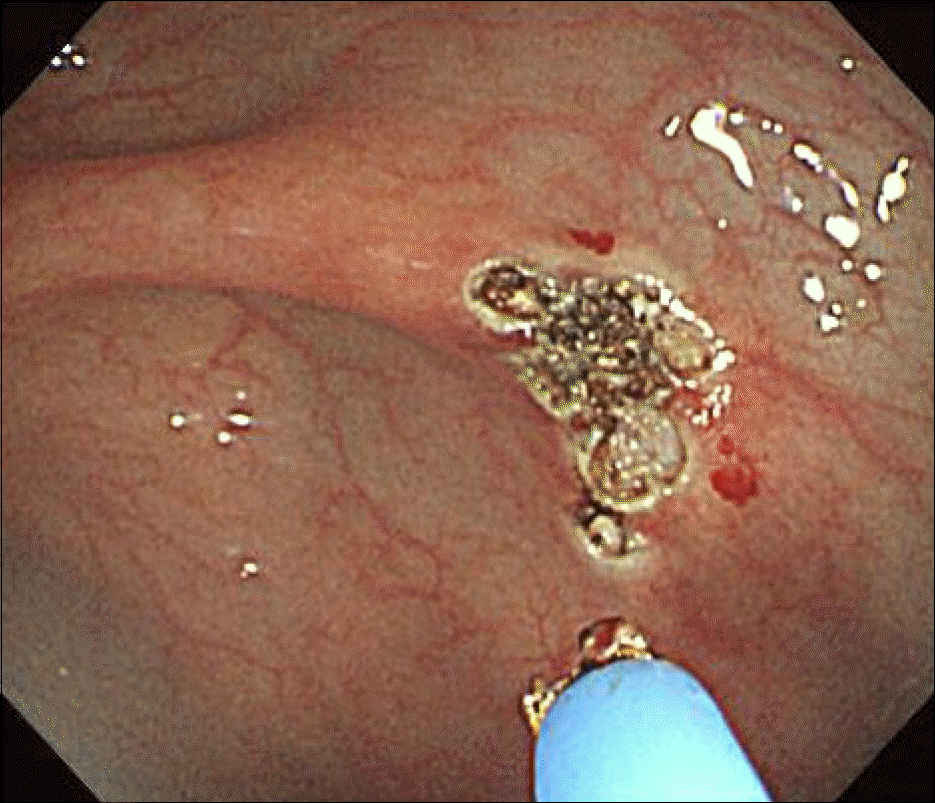Abstract
Spontaneous bacterial peritonitis (SBP) is the most common infection in liver cirrhosis patients, and is not a result of surgery or intra abdominal infection. Argon plasma coagulation (APC) is an endoscopic procedure used with a high-frequency electrical current for control of bleeding from gastrointestinal vascular ectasias including angiodysplasia and gastric antral vascular ectasia. This procedure is known to be safe because it uses a noncontact method. Therefore, tissue injury is minimal and up to two to three millimeters. However, we experienced a case of SBP occurring immediately after performance of APC for control of severe bleeding from angiodysplasia in the colon in a patient with liver cirrhosis and hepatocellular carcinoma.
References
1. Ginés P, Rimola A, Planas R, et al. Norfloxacin prevents spontaneous bacterial peritonitis recurrence in cirrhosis: results of a double-blind, placebo-controlled trial. Hepatology. 1990; 12:716–724.

2. Silva RA, Correia AJ, Dias LM, Viana HL, Viana RL. Argon plasma coagulation therapy for hemorrhagic radiation proctosigmoiditis. Gastrointest Endosc. 1999; 50:221–224.

3. Taïeb S, Rolachon A, Cenni JC, et al. Effective use of argon plasma coagulation in the treatment of severe radiation proctitis. Dis Colon Rectum. 2001; 44:1766–1771.

4. Grund KE, Storek D, Farin G. Endoscopic argon plasma coagulation (APC) first clinical experiences in flexible endoscopy. Endosc Surg Allied Technol. 1994; 2:42–46.
5. Ben Soussan E, Mathieu N, Roque I, Antonietti M. Bowel explosion with colonic perforation during argon plasma coagulation for hemorrhagic radiation-induced proctitis. Gastrointest Endosc. 2003; 57:412–413.
6. Fernández J, Navasa M, Gómez J, et al. Bacterial infections in cirrhosis: epidemiological changes with invasive procedures and norfloxacin prophylaxis. Hepatology. 2002; 35:140–148.

7. Suzuki K, Takikawa Y. Marked improvement in the resolution of, and survival rates in, spontaneous bacterial peritonitis. J Gastroenterol. 2002; 37:149–150.

8. Garcia-Tsao G. Identifying new risk factors for spontaneous bacterial peritonitis: how important is it? Gastroenterology. 1999; 117:495–499.

9. Song HG, Lee HC, Joo YH, et al. Clinical and microbiological characteristics of spontaneous bacterial peritonitis (SBP) in a recent five year period. Taehan Kan Hakhoe Chi. 2002; 8:61–70.
10. Park MK, Lee JH, Byun YH, et al. Changes in the profiles of causative agents and antibiotic resistance rate for spontaneous bacterial peritonitis: an analysis of cultured microorganisms in recent 12 years. Korean J Hepatol. 2007; 13:370–377.

11. Seo YS, Um SH, Yim HJ, et al. Clinical features and outcomes of spontaneous bacterial peritonitis in patients with cirrhosis. Korean J Hepatol. 2007; 13(Suppl 3):S71.
12. Lee MR, Chon JY, Moon YM, Park IS, Lee KW. Efficacy of ascitic fluid culture technique using blood culture media in the diagnosis of spontaneous bacterial peritonitis. Korean J Gastroenterol. 1995; 27:659–671.
13. Bernard B, Grangé JD, Khac EN, Amiot X, Opolon P. Poynar Antibiotic prophylaxis for the prevention of bacterial infectio in cirrhotic patients with gastrointestinal bleeding: a me analysis. Hepatology. 1999; 29:1655–1661.
14. Chiu YC, Lu LS, Wu KL, et al. Comparison of argon plasma coagulation in management of upper gastrointestinal angiodysplasia and gastric antral vascular ectasia hemorrhage. BMC Gastroenterol. 2012; 12:67.

15. Poole GV. Spontaneous bacterial peritonitis during bowel preparation: an example of clinical translocation. South Med J. 1991; 84:1412–1413.

16. Gumpenberger C, Kirchgatterer A, Wallner M, Kramar R, Prischl FC. Peritonitis following argon plasma coagulation of colonic angiodysplasia in a CAPD patient–an avoidable complication? Perit Dial Int. 2005; 25:500–502.




 PDF
PDF ePub
ePub Citation
Citation Print
Print




 XML Download
XML Download